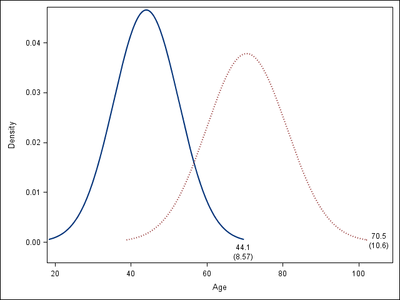- Home
- /
- Programming
- /
- Graphics
- /
- About inset statement: proc sgplot vs. proc univariate
- RSS Feed
- Mark Topic as New
- Mark Topic as Read
- Float this Topic for Current User
- Bookmark
- Subscribe
- Mute
- Printer Friendly Page
- Mark as New
- Bookmark
- Subscribe
- Mute
- RSS Feed
- Permalink
- Report Inappropriate Content
I apply the proc sgplot to put two PDF curves on one graph, like the code below:
proc sgplot data=have;
density var1 / legendlabel="var1" lineattrs=(pattern=solid);
density var2 / legendlabel="var2" lineattrs=(pattern=dot);
xaxis label="value";
run;
then, I try to add the mean and std for both curves, which can be done in proc univariate by the inset statement:
inset normal(mu sigma);
I think that the inset statement does not work in the same way in proc sgplot as it does in proc univariate. Any idea to let the above proc sgplot also output mean and std for both PDF curves? Thanks!
Accepted Solutions
- Mark as New
- Bookmark
- Subscribe
- Mute
- RSS Feed
- Permalink
- Report Inappropriate Content
Here is an example of one of many ways to display these statistics:
proc univariate data=sashelp.heart noprint;
var ageatstart ageatdeath;
output out=ageStats mean=muStart muDeath std=stdStart stdDeath;
run;
data _null_;
set ageStats;
str = catt(put(muStart,4.1),"/(",put(stdStart,4.2),")");
call symputx("startLabel",str);
str = catt(put(muDeath,4.1),"/(",put(stdDeath,4.2),")");
call symputx("deathLabel",str);
run;
proc sgplot data=sashelp.heart;
density ageatstart / legendlabel="Start Age"
curvelabel="&startLabel" curvelabelpos=max splitchar="/" splitjustify=center
lineattrs=(pattern=solid);
density ageatdeath / legendlabel="Death Age"
curvelabel="&deathLabel" curvelabelpos=max splitchar="/" splitjustify=center
lineattrs=(pattern=dot);
xaxis label="Age";
run;- Mark as New
- Bookmark
- Subscribe
- Mute
- RSS Feed
- Permalink
- Report Inappropriate Content
Yes, you are exactly right. PROC SGPLOT is primarily a graphical procedure. It does not contain the same analytical capabilities as ROC UNIVARIATE. In particular, the INSET statement requires that you specify the text to display, which means you probably want to use PROC UNIVARIATE to fit the distribution to the data. Let's say that PROC UNIVARIATE displays a table that states that the parameters are mu=1.2 and sigma=3.4. Then you might use the following INSET statement in PROC SGPLOT:
inset ("mu" = "1.2" "sigma" = "3.4") / border;
- Mark as New
- Bookmark
- Subscribe
- Mute
- RSS Feed
- Permalink
- Report Inappropriate Content
Here is an example of one of many ways to display these statistics:
proc univariate data=sashelp.heart noprint;
var ageatstart ageatdeath;
output out=ageStats mean=muStart muDeath std=stdStart stdDeath;
run;
data _null_;
set ageStats;
str = catt(put(muStart,4.1),"/(",put(stdStart,4.2),")");
call symputx("startLabel",str);
str = catt(put(muDeath,4.1),"/(",put(stdDeath,4.2),")");
call symputx("deathLabel",str);
run;
proc sgplot data=sashelp.heart;
density ageatstart / legendlabel="Start Age"
curvelabel="&startLabel" curvelabelpos=max splitchar="/" splitjustify=center
lineattrs=(pattern=solid);
density ageatdeath / legendlabel="Death Age"
curvelabel="&deathLabel" curvelabelpos=max splitchar="/" splitjustify=center
lineattrs=(pattern=dot);
xaxis label="Age";
run;- Mark as New
- Bookmark
- Subscribe
- Mute
- RSS Feed
- Permalink
- Report Inappropriate Content
Thank you all for your kindly help
- Mark as New
- Bookmark
- Subscribe
- Mute
- RSS Feed
- Permalink
- Report Inappropriate Content
I add name="curve1" and name="curve2" in those two density statements, separately. So that legendlabel can also display.
April 27 – 30 | Gaylord Texan | Grapevine, Texas
Registration is open
Walk in ready to learn. Walk out ready to deliver. This is the data and AI conference you can't afford to miss.
Register now and lock in 2025 pricing—just $495!
Learn how use the CAT functions in SAS to join values from multiple variables into a single value.
Find more tutorials on the SAS Users YouTube channel.
SAS Training: Just a Click Away
Ready to level-up your skills? Choose your own adventure.




